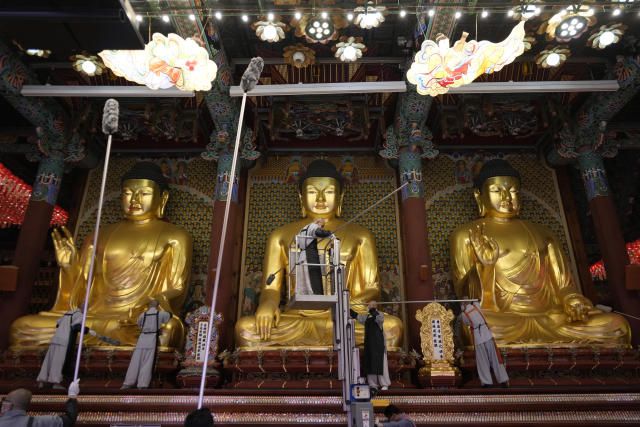뉴스&스피킹(영자신문)
하루 10분이면 영어에 대한 두려움을 극복하고 누구나 유창하게 영어를 구사하실 수 있습니다.
-
_3507_1image.jpg) Brazilian State Lawmakers Declare a Dance ‘Cultural Heritage’ A dance that started in some of Brazil’s poorest neighborhoods is being honored by Rio de Janeiro state lawmakers.
Brazilian State Lawmakers Declare a Dance ‘Cultural Heritage’ A dance that started in some of Brazil’s poorest neighborhoods is being honored by Rio de Janeiro state lawmakers.
The passinho started with leg movements, strong steps backwards and forwards, while moving to a Brazilian form of funk music. It took moves from dance styles like break dancing, samba, capoeira and frevo.
Young people in Rio de Janeiro’s poor neighborhoods known as favelas started the dance style. Rio de Janeiro state lawmakers declared the dance a piece of “cultural heritage” in March. The declaration honors a cultural expression from the favelas.
The creators of the passinho were young people and children. They started trying out new moves at home and then showing them off at funk parties in their communities. The dances became more popular after people started sharing them on the internet.
In the early days of social media, people shared videos of their dance moves on Orkut and YouTube. The style started spreading to other favelas and competitions started. The young people copied and learned from the top dancers, leading them to invent new moves.
“Passinho in my life is the basis of everything I have,” dancer and choreographer Walcir de Oliveira told the Associated Press. “It's where I manage to earn my livelihood, and I can show people my joy and blow off steam,” he said. “It's where I feel happy, good.”
Brazilian producer Julio Ludemir helped discover new dancers by organizing “passinho battles” in the early 2010s. At these events, youths took turns showing off their steps before a jury that chose the winners.
A music and dance event in New York City held a competition in 2014. It showed Americans the dance style. Dancers started appearing on popular TV shows and performed at the opening ceremony of the Rio de Janeiro 2016 Olympic Games.
Ludemir describes the style as an expression of Brazilian culture, called “cannibalism.” That is the idea of taking elements from other cultures to produce something new. He said the passinho is a dance that takes elements “from all dances. It’s a crossing of the cultural influences absorbed by kids…as they were connecting with the world through social media in internet cafes.”
Supporters say dancing also became a way for young people from the favelas to avoid becoming criminals. Rio state legislator Veronica Lima proposed the law honoring the passinho. In a statement, Lima said it was important to help “decriminalize funk and artistic expressions of youths” from the favelas.
Ludemir said the declaration honors the first generation of passinho dancers as examples for favela youths.
Among them is Pablo Henrique Goncalves. He won a passinho battle back in 2014 and created a boy group called OZCrias. The group has four dancers from Rocinha, Rio de Janeiro’s largest favela. The group earns money performing.
Another dance group is Passinho Carioca in the Penha favelas on the other side of the city. One of its leaders, Nayara Costa, said she came from a family where everyone was involved in selling drugs. She said Passinho saved her from that life. Now she uses dance to help young people and teach anyone interested in learning.
“Today I give classes to people who are in their sixties; passinho is for everyone," said Costa, who is 23. "Passinho, in the same way that it changed my life, is still going to change the lives of others.”
I’m Dan Novak.View -
 US Agency Permits Qualified Health Claim for Yogurt From VOA Learning English, this is the Health & Lifestyle report.
US Agency Permits Qualified Health Claim for Yogurt From VOA Learning English, this is the Health & Lifestyle report.
The U.S. Food and Drug Administration (FDA) recently permitted yogurt producers to make a health claim on containers of their products.
Yogurt is a food made from milk and special bacteria.
The claim is that eating yogurt might reduce the risk of type 2 diabetes, a health problem linked to how the body uses sugar for fuel. Type 2 diabetes is believed to affect about 38 million Americans.
Danone North America is the U.S. division of a French food company that makes several popular yogurt products. In 2018, the company asked the FDA for permission to make what is known as a “qualified health claim” about yogurt.
In March, the FDA said it would not object to such a claim. The food agency said that there is some evidence to support the claim that eating at least 900 grams of yogurt per week might reduce the risk of developing type 2 diabetes.
However, the agency said there is not “significant scientific agreement” about the claim.
What is a ‘qualified health claim’?
A “qualified health claim” means that the health effects have not been supported by wide scientific agreement.
Food producers are permitted to make some claims about the healthfulness of their products, but they also must include additional information to prevent misleading the public.
The FDA has permitted “qualified health claims” on dietary supplements since 2000 and on foods since 2002. The policy formed after the FDA faced legal action in the 1990s because it did not permit food companies to put any health claims on products that the agency did not approve. Lawyers successfully argued that such bans violated free speech rights guaranteed by the First Amendment of the U.S. Constitution.
Rather than fight in court, the FDA created a new term, separate from “authorized health claims.” These claims, the agency says, are supported by scientific agreement.
Examples of “qualified health claims” include claims that eating some kinds of cocoa might reduce heart disease. Another example is that cranberry juice might cut the risk of repeated urinary tract infections in women.
Yogurt and type 2 diabetes
In the case of yogurt, Danone submitted information from studies that observed people over time. The yogurt company found a link between eating yogurt and fewer signs of diabetes. The FDA agreed that there is “some credible evidence” that eating yogurt as a whole food has good health effects but not because of any one nutrient that it contains. In other words, there is no direct evidence that yogurt can prevent diabetes. There is only indirect evidence that eating yogurt may be connected to reducing signs connected to an increased risk of the disease.
The FDA says that it will not object to a qualified health claim rather than authorizing it.
Critics questioned the use of such a claim. They say it is not based on research that proves yogurt reduces Type 2 diabetes risk.
The Center for Science in the Public Interest is a nonprofit advocacy group based in Washington, D.C. It is critical of the qualified health claim related to yogurt. It said no single food can reduce the risk of a disease that is tied to overall diet.
It even warned that the claim might raise the risk of diabetes. The center said people might eat more yogurt products that include added sugars including cookies and pretzels—even if they do not have the claim on their containers.
Marion Nestle is a food policy expert at New York University. She said qualified health claims based on limited evidence are “ridiculous on their face.”
And that’s the Health & Lifestyle report. I’m Anna Matteo.View -
 Less or No Alcohol Is Better for Health From VOA Learning English, this is the Health & Lifestyle report.
Less or No Alcohol Is Better for Health From VOA Learning English, this is the Health & Lifestyle report.
Alcohol is often consumed in social gatherings from happy hours after work to birthday parties on the weekend. Drinking some alcohol is normal and believed to be good for heart health.
However, new research may have put an end to that idea.
Dr. Timothy Naimi directs the Canadian Institute for Substance Use Research at the University of Victoria. He said, “Drinking less is a great way to be healthier.”
Are drinking guidelines changing?
Guidelines, or advice, for drinking alcohol differ greatly from country to country. But overall, the advice has been moving toward drinking less.
Britain, France, Denmark, Holland, and Australia recently reviewed new evidence and lowered the suggested amount of alcohol consumption.
Ireland went further than most. It will require cancer warning descriptions on alcohol starting in 2026.
Carina Ferreira-Borges is an adviser for alcohol at the World Health Organization office for Europe. She said scientists see “evidence linking alcohol to over 200 health conditions, including cancers, cardiovascular diseases and injuries.”
Overall, people may have already been moving toward drinking less alcohol. Social calendar events called “Dry January” and “Sober October” are celebrated with non-alcoholic drinks. "Dry" means no alcohol. And a sober person is not affected by alcohol.
“People my age are way more accepting of it,” said Tessa Weber. The 28-year-old from Austin, Texas said she stopped drinking for Dry January after seeing how alcohol increased her anxiety. She liked the results — better sleep, more energy — and has stuck with it.
Flawed studies on alcohol
The idea that alcohol can be heart-friendly came from imperfect studies comparing groups of people by how much they drink.
Usually, alcohol consumption was measured at one point in time. And none of them compare drinkers and non-drinkers. As a result, these studies could not prove cause and effect.
People who report drinking an average amount of alcohol usually have higher income, education, and better health care. “It turns out that when you adjust for those things, the benefits tend to disappear,” Dr. Naimi said.
Most studies also did not include younger people. And almost half of the people who die from alcohol-related causes die before the age of 50.
“If you’re studying people who survived into middle age, didn’t quit drinking because of a problem and didn’t become a heavy drinker, that’s a very select group,” Naimi said. “It creates an appearance of a benefit for moderate drinkers.”
Other studies challenge the idea that alcohol has benefits.
These studies compare people with a certain gene variant that makes it unpleasant to drink to people without this gene variant. People with this gene tend to drink very little or not at all. One of these studies found people with the gene variant have a lower risk of heart disease. This may supply more proof that alcohol does not protect people from heart problems.
How many drinks per day is safe?
So, how many alcoholic drinks can people safely have every day? That depends.
Drinking alcohol raises the risk of several kinds of cancer, including colon, liver, breast, mouth, and throat. Alcohol breaks down in the body into a substance called acetaldehyde. This substance can damage your cells and stop them from repairing themselves. That creates the conditions for cancer to grow.
Thousands of U.S. deaths per year could be prevented if people follow the U.S. government’s guidelines. They advise men to limit themselves to two drinks or fewer per day and women to one drink or fewer per day, Naimi said.
One drink is the equivalent of about one can of beer, a glass of wine, or a very small glass of hard alcohol.
Naimi served on an advisory committee. That committee wanted to lower the guideline for men to one drink per day. However, that advice was rejected when the federal guideline came out in 2020.
“The simple message that’s best supported by the evidence is that, if you drink, less is better when it comes to health,” Naimi said.
On its website, the National Institute of Health says some people should not consume alcohol at all. The agency says to avoid alcohol completely if you are:
Taking medications that interact with alcohol
Having a medical condition that can be made worse by drinking
Under the age of 21, the minimum legal drinking age in the U.S.
Recovering from alcohol use disorder or unable to control the amount you drink
Pregnant or might become pregnant
And that’s the Health & Lifestyle report. I’m Anna Matteo.View -
 In Asia, Buddha’s Birthday Is Celebrated in Different Ways In ancient India, the term “Buddha” was used to describe someone who has awakened from ignorance and gained freedom from suffering. Buddha means the “enlightened one.”
In Asia, Buddha’s Birthday Is Celebrated in Different Ways In ancient India, the term “Buddha” was used to describe someone who has awakened from ignorance and gained freedom from suffering. Buddha means the “enlightened one.”
Today, the names Buddha, Siddhartha, Shakyamuni, Gautama or Phật are used to describe a historical person born around 2,500 years ago. His followers started the religion of Buddhism, which is widely practiced in many Asian countries.
Some countries observe his birthday on the fourth month of the Buddhist calendar, which falls on May 15 this year. Others celebrate it on the first full moon of May, which falls on May 23.
Buddha’s birth and life
Buddha, or Prince Siddhartha, was born in Lumbini, an area at the border of what is today India and Nepal. His mother, Maya, was the wife of Suddhodana, king of the Shakya families.
Ancient storytellers said that Queen Maya dreamed of a white elephant entering her womb before giving birth. The child took seven steps soon after he was born and received a cleansing bath from the gods, or dragon kings, depending on the country or culture where the story is told.
Suddhodana tried to keep his son from knowledge of pain and suffering. Before long, the prince witnessed and learned of sickness, old age, death and the impermanence of life. At the age of 35, Siddhartha was enlightened and became known as the Buddha.
Followers use the time of Buddha’s birthday to celebrate and to reflect on his teachings and their faith. In many parts of Asia, the day marks the birth, the enlightenment and passing of the Buddha.
In most Asian cultures, Buddhists go to their local religious centers, or temples, and take part in chanting, meditation and activities all day. Families decorate their homes with lights called lanterns and gather for big meals.
Koreas
Buddha’s birthday is a national holiday in South Korea.
The big celebration in the capital city of Seoul is the lotus lantern festival called Yeondeunghoe. It is a parade of thousands of colorful, lighted paper lanterns often shaped like lotus flowers.
On Buddha’s birthday, many temples provide free meals and tea to all visitors. Other festivities include traditional games and performing arts to mark the light of Buddha’s teachings.
While Buddha’s birthday is not an official holiday in North Korea, it has been observed in Buddhist temples there since 1988.
In 2018, Buddhist clergy in North and South Korea held joint services when tensions between their governments eased. But such exchange programs have been halted in the past few years because of North Korea’s nuclear program.
China
In China, Buddhists perform a bathing ceremony that involves pouring holy water over a statue of the infant Buddha.
The statue has one right finger pointing up to the sky and one left finger pointing down to the earth. This means that with his birth, Buddha announced that he would have no more rebirths, and the dragons of heaven baptized him with pure water.
Japan
In Japan, Buddha’s birthday is observed on April 8 and celebrated in Buddhist temples as Hana Matsuri, which means flower festival.
On this day, a small “flower hall” is set up on the temple grounds and decorated with colorful flowers. Followers pour sweet tea on the head of a statue of the baby Buddha in a bowl of water. And a cleric performs the Kambutsu-e ceremony recreating Buddha’s birth in the garden of Lumbini.
South and Southeast Asia
Countries in South and Southeast Asia celebrate Buddha’s birthday on the full moon of the second lunar month known as Vesakha or Vaisakha.
In India and Nepal, sweet rice porridge is served on this day to recall Sujata, a young woman who offered the Buddha a bowl of milk porridge.
In Sri Lanka, celebrants decorate homes and streets with candles and lanterns. They sing songs, burn incense and tell stories about Buddha’s life.
In Vietnam, Buddha’s birthday is still a popular festival, but no longer a public holiday. Between 1958 and 1975, in what was formerly South Vietnam, it was a public holiday.
In Malaysia, China and many other countries, animals and birds are also set free on Buddha’s birthday because people believe it is good karma.
I’m Gena Bennett.View -
 Researchers: Smarter Vehicles Could Greatly Change Traffic Signals Researchers say the rise of more smart and connected vehicles on American roads could lead to big changes for traffic signals.
Researchers: Smarter Vehicles Could Greatly Change Traffic Signals Researchers say the rise of more smart and connected vehicles on American roads could lead to big changes for traffic signals.
The current U.S. traffic signal system has been in existence for more than 100 years. But experts are now studying ways to link technology-equipped vehicles to signal systems in an attempt to improve safety and traffic flows.
One research effort is led by a team at North Carolina State University. Engineering professor Ali Hajbabaie is the leader of that research. He told The Associated Press one major change that signal systems could see is different colored lights.
Most U.S. traffic signals currently include three lights to direct drivers at intersections: red, yellow and green. But Hajbabaie said it might make sense to add a fourth color, possibly white.
This color could inform motorists when there is a large collection of self-driving vehicles in a particular area. When many self-driving vehicles are present, the additional light would signal other drivers to follow the lead of those vehicles.
“When we get to the intersection, we stop if it's red and we go if it's green," said Hajbabaie. “But if the white light is active, you just follow the vehicle in front of you.”
The North Carolina State team estimated that such changes are likely years away. Hajbabaie said one reason for this is because this kind of system would require between 40 to 50 percent of all vehicles on the road to be self-driving.
Sandy Karp is a spokesperson for Waymo. Waymo is a self-driving vehicle company owned by Google’s parent, Alphabet. She told the AP that Waymo had already launched ride-sharing services that use full self-driving vehicles in Los Angeles, California and Austin, Texas. Those services do not use a fourth traffic light.
In an email to the AP, Karp said she thought it was good that researchers are currently “thinking creatively” about ways to change traffic light signals to improve safety and traffic flows. However, she said that officials and companies should think very carefully before deciding on, and moving forward with, major infrastructure changes.
Researchers at the University of Michigan are also testing different methods. They have carried out a test program in an area outside the city of Detroit. Their research collects data on the speed and location of General Motors (GM) vehicles in the area. The data has been used to change the timing of city traffic lights in an effort to improve traffic flows.
Henry Liu is a civil engineering professor at the University of Michigan. He helped lead the research. He said the launch of a new U.S. traffic system could be a lot closer than people might think.
Liu said that even with as few as 6 percent of vehicles connected to the GM system, there is still enough data to change the timing of the traffic lights enough to smooth traffic flows.
The area near Detroit where the testing is taking place has 34 traffic signals. It was chosen because lights in the area are set to change at the same times each day. This is the case for more than half of traffic signals nationwide. These signals are not connected to cameras or sensors to watch traffic flows in real time.
Liu noted that higher-tech solutions will require cities to make complex and costly investments.
“The beauty of this is you don’t have to do anything to the infrastructure,” Liu said. “The data is not coming from the infrastructure. It’s coming from the car companies.”
Danielle Deneau is the director of traffic safety at the Road Commission in Oakland County, Michigan. She said results of the University of Michigan research changed the timing of green lights only by a few seconds. However, Deneau added, even that was enough to improve traffic flows.
I’m Bryan LynnView

